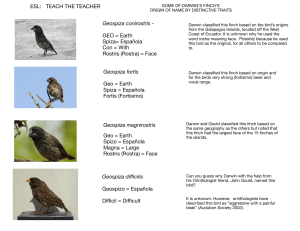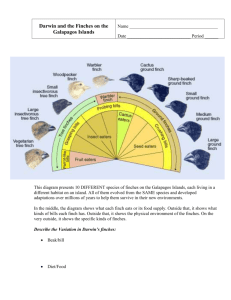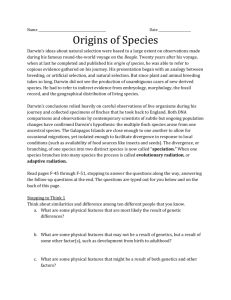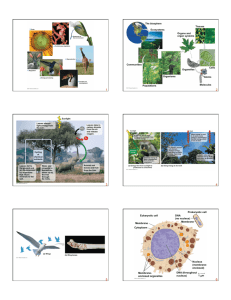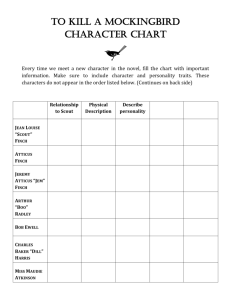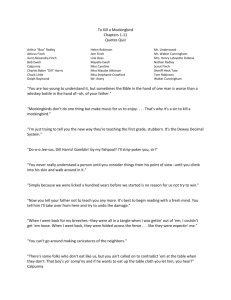Bio1BEvol L1
advertisement
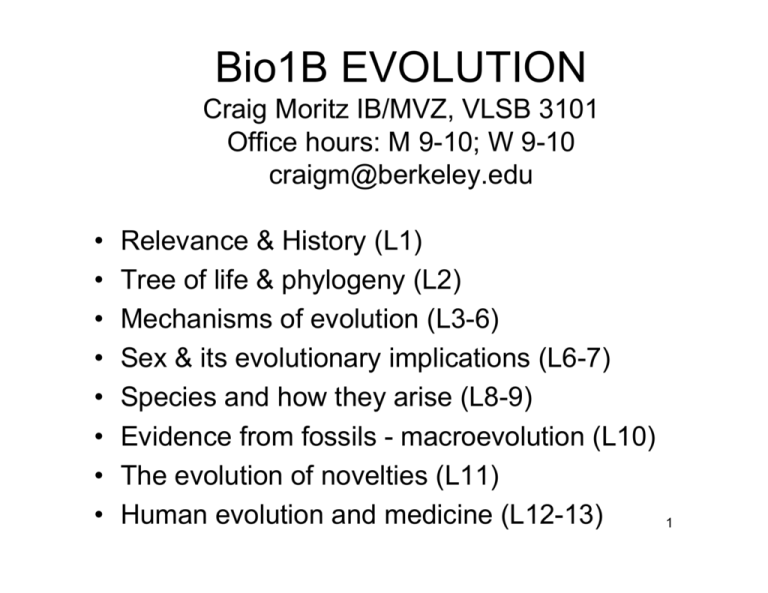
Bio1B EVOLUTION Craig Moritz IB/MVZ, VLSB 3101 Office hours: M 9-10; W 9-10 craigm@berkeley.edu • • • • • • • • Relevance & History (L1) Tree of life & phylogeny (L2) Mechanisms of evolution (L3-6) Sex & its evolutionary implications (L6-7) Species and how they arise (L8-9) Evidence from fossils - macroevolution (L10) The evolution of novelties (L11) Human evolution and medicine (L12-13) 1 Why does evolution matter? • Understanding our own species – Origins, variation, health => evolutionary medicine • The arms race with pathogens – Antibiotic resistance; HIV control etc. • …. and insect pests of agriculture – Insecticide resistance • Saving biodiversity on a rapidly changing planet – Invasive species – Overharvesting – Habitat loss & climate change 2 LE 22-13 Percent of HIV resistant to 3TC 100 Patient No. 1 Patient No. 2 75 Penicillin: Discovered: 1929 (Fleming) 50 Patient No. 3 Mass production: 1943 Resistance appears: 1947 (Staphylococcus aureus) 25 0 0 2 4 6 Weeks 8 10 12 Development of the theory of evolution Aristotle (384-322 BC) • Species fixed, scala naturae Linnaeus (1707-78) • Hierarchical classification binomial system Mutability of species • Lamarck, E. Darwin Geological change • Hutton, Lyell (uniformitarianism) Fossil record, extinction • Cuvier Biogeography • Humboldt, de Candolle Population pressure • Malthus Linnaean hierarchy Fig 1.14 4 LE 22-2 Linnaeus (classification) Hutton (gradual geologic change) Lamarck (species can change) Malthus (population limits) Cuvier (fossils, extinction) Lyell (modern geology) Darwin (evolution, natural selection) Mendel (inheritance) Wallace (evolution, natural selection) American Revolution U.S. Civil War French Revolution 1850 1900 1750 1800 1795 Hutton proposes his theory of gradualism. 1798 Malthus publishes “Essay on the Principle of Population.” 1809 Lamarck publishes his theory of evolution. 1830 Lyell publishes Principles of Geology. 1831–1936 Darwin travels around the world on HMS Beagle. 1837 Darwin begins his notebooks on the origin of species. 1844 Darwin writes his essay on the origin of species. 1858 Wallace sends his theory to Darwin. 1859 The Origin of Species is published. 1865 Mendel publishes inheritance papers. Early influences Henslow - nat hist Humboldt explorer, biogeography Sedgwick Geology Charles Lyell geology, uniformitarianism 6 The Voyage of the Beagle • Mapping coastlines • Capt. Robert Fitzroy • Darwin as 22 yr old companion naturalist • Dec 17 1831 - Oct 1836 • 28m x 7m - 74 people • Darwin’s cabin: 11ft wide, with 6.5 ft chart table; shared. – compare to your dorm? 7 Replica @ Down House with Darwin hologram! Darwin’s mockingbirds 8 Large ground finch Large cactus ground finch The amazing variety of Darwin’s finches - 14 “species” descended from a common ancestor Geospiza magnirostris Sharp-beaked ground finch Geospiza conirostris Geospiza fuliginosa Medium ground finch Camarhynchus psittacula Woodpecker finch Geospiza difficilis Cactus ground finch Mangrove finch Geospiza fortis Geospiza scandens Seed eater Cactospiza pallida Medium tree finch Camarhynchus pauper Small tree finch Cactus flower eaters Green warbler finch Gray warbler finch Certhidea olivacea Certhidea fusca Camarhynchus parvulus Cactospiza heliobates Vegetarian finch Seed eaters Platyspiza crassirostris Insect eaters Ground finches Fig. 1-23 Large tree finch Small ground finch Tree finches Bud eater Warbler finches Common ancestor from South American mainland And then there was Alfred R. Wallace… (1823 - 1913) Professional collector - trained in nat hist, geology, surveying Amazon: 1848-52 (most collection lost) SE Asian islands: 1954-62 (“Wallace’s line”) Sarawak law (1855) “Every species has come to existence coincident both in time and space with a pre-existing, closely related allied species” (1858) “On the Tendency of Varieties to Depart Indefinitely From the Original Type” - evolution by natural selection 10 time Descent with modification The only figure in “Origin of the species” 11 The Darwin-Wallace principle of Natural selection • Individuals within a population vary for one or more characteristics (traits) • Traits are (to some extent) inherited by offspring from their parents • More offspring are produced than can survive => those with traits that improve survival/reproduction leave more offspring => these favorable traits will accumulate in the population over generations 12

